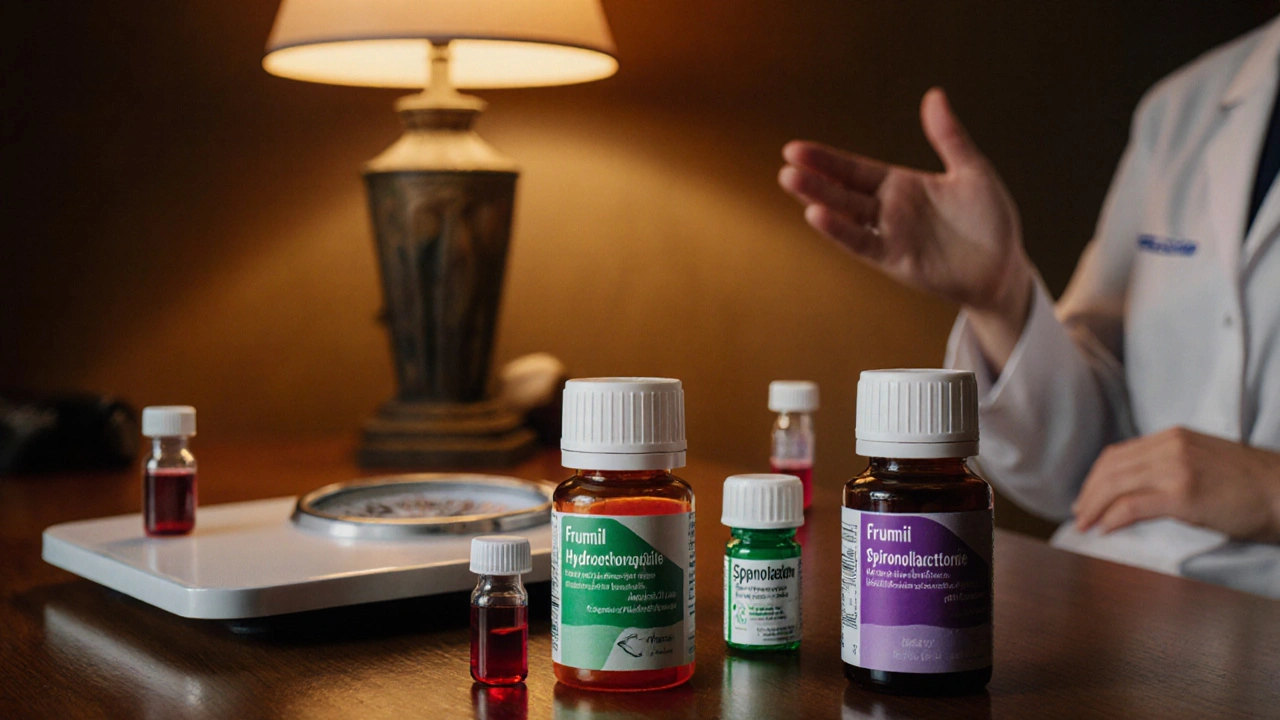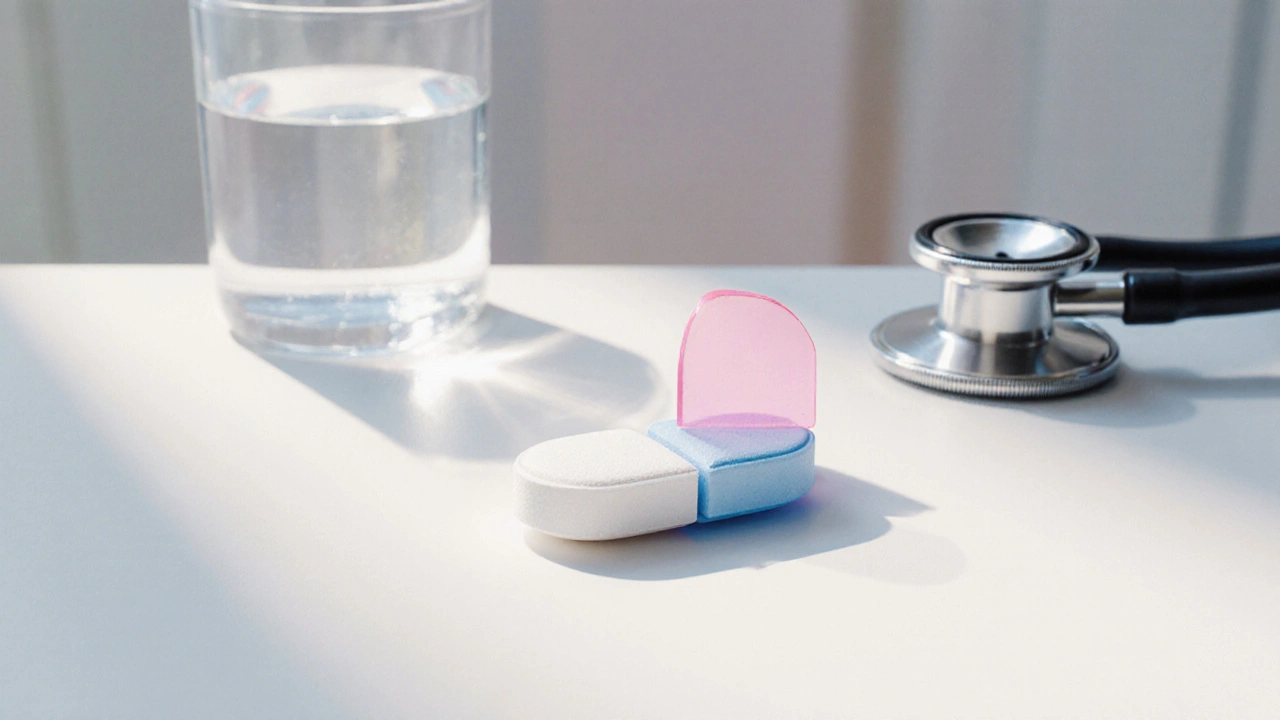Frumil vs Other Diuretics Comparison Tool
Recommended Diuretic Options
| Diuretic | Strengths | Best For |
|---|
Key Takeaways
- Frumil combines a potassium‑sparing diuretic (amiloride) with a loop diuretic (furosemide) for balanced fluid removal.
- It works faster than thiazides but may need extra monitoring of electrolytes.
- Hydrochlorothiazide is cheaper and good for mild hypertension, while spironolactone adds stronger potassium‑sparing effects.
- Bumetanide and torsemide are more potent loop options for resistant edema.
- Choosing the right diuretic depends on the condition, kidney function, and how your body handles potassium.
When you hear the name Frumil, you’re looking at a specific combination pill that pairs two very different types of diuretics. Below is a straight‑forward look at what it does, how it stacks up against other common options, and which scenarios make it a smart pick.
Frumil is a tablet that contains 5mg of amiloride (a potassium‑sparing diuretic) and 40mg of furosemide (a loop diuretic). It is prescribed to treat edema associated with heart failure, liver cirrhosis, or renal disease, and to help control high blood pressure when fluid overload is a concern.
After that brief intro, let’s dig into the chemistry, the clinical use, and the alternatives you might encounter.
How Frumil Works - The Double‑Action Formula
Amiloride is a potassium‑sparing diuretic that inhibits sodium channels in the distal convoluted tubule. By preventing sodium reabsorption, it reduces water retention while allowing potassium to stay in the bloodstream.
Furosemide belongs to the loop diuretic class and blocks the Na‑K‑2Cl transporter in the thick ascending limb of the loop of Henle. This creates a strong diuretic surge, flushing out large volumes of fluid quickly.
The synergy means you get rapid fluid loss from furosemide, while amiloride helps curb the potassium loss that loops usually cause. The net effect is a balanced diuresis that’s gentler on the heart’s electrolyte balance.
Typical Dosing and Pharmacokinetics
- Standard adult dose: one tablet (5mg amiloride+40mg furosemide) once or twice daily, depending on severity.
- Onset of action: 30-60minutes after ingestion.
- Peak effect: 2-4hours, lasting up to 6hours.
- Renal clearance: Both components are excreted unchanged in urine; dose adjustment required in severe renal impairment (eGFR <30mL/min).
Because amiloride has a longer half‑life (≈12hours) than furosemide (≈2hours), the potassium‑sparing effect persists after the diuretic surge has faded.
Alternative Diuretics - What’s on the Market?
Below is a quick snapshot of other diuretics you’ll often see prescribed, each with its own strengths and weaknesses.
| Drug | Class | Typical Dose | Onset | Duration | Key Side Effects | Best For |
|---|---|---|---|---|---|---|
| Frumil | Combination (Potassium‑sparing + Loop) | 5mg+40mg tablet | 30-60min | 4-6h | Hypokalemia (reduced), dizziness, GI upset | Moderate to severe edema with risk of potassium loss |
| Hydrochlorothiazide | Thiazide | 12.5-50mg daily | 1-2h | 6-12h | Hypokalemia, hyperuricemia, photosensitivity | Mild hypertension, mild edema |
| Spironolactone | Potassium‑sparing (Aldosterone antagonist) | 25-100mg daily | 2-4h | 12-24h | Hyperkalemia, gynecomastia, menstrual irregularities | Heart failure with preserved potassium, resistant hypertension |
| Bumetanide | Loop | 0.5-2mg daily | 15-30min | 3-5h | Hypokalemia, ototoxicity, dehydration | Severe edema requiring high potency |
| Torsemide | Loop | 5-20mg daily | 30-60min | 6-8h | Hypokalemia, rash, liver enzyme elevation | Chronic heart failure, long‑term outpatient management |
| Indapamide | Thiazide‑like | 1.5mg daily | 2h | 12-24h | Hypokalemia, hyperglycemia, photosensitivity | Hypertension, especially in older adults |

When Frumil Is the Right Choice
Doctors often reach for Frumil when they need a rapid fluid shift but are worried about dropping potassium too low. Typical scenarios include:
- Acute decompensated heart failure with pulmonary congestion.
- Severe liver cirrhosis‑related ascites where aggressive loop therapy is needed.
- Renal patients on multiple diuretics who have shown borderline low potassium.
In each case, the built‑in amiloride helps blunt the potassium‑wasting effect of furosemide, reducing the need for separate potassium supplements.
When to Pick an Alternative Instead
If you have any of the following, another diuretic might be a better fit:
- Stable hypertension without fluid overload: A thiazide like hydrochlorothiazide or indapamide is cheaper and effective.
- Risk of hyperkalemia (e.g., chronic kidney disease stage4+): Avoid potassium‑sparing combos; consider pure loop agents or thiazides.
- Need for long‑term potassium retention: Spironolactone offers stronger aldosterone blockade.
- Concern about ototoxicity: Bumetanide can cause ear damage at high doses; Torsemide is generally safer.
Practical Tips for Patients on Frumil
- Take the tablet in the morning with food to lessen stomach upset.
- Monitor your weight daily; a sudden loss of >2kg may indicate excessive diuresis.
- Check potassium levels every 1-2weeks during the first month, then quarterly.
- Stay hydrated, but avoid large volumes of sugary drinks that can spike blood sugar.
- Inform your doctor about any over‑the‑counter NSAIDs or supplements, as they can affect kidney function.
Following these steps helps you reap the benefits of Frumil while keeping side effects in check.
Decision Guide - Choosing the Best Diuretic for You
Use the quick decision tree below to narrow down the right medication based on your primary condition and lab values.
- Do you have significant fluid overload?
- Yes → Loop diuretic needed.
- Concern about potassium loss? → Choose Frumil or add amiloride separately.
- Very high dose needed? → Consider Bumetanide (more potent) or Torsemide (longer acting).
- No → Look at thiazide‑like agents.
- Older adult with isolated hypertension? → Indapamide.
- Budget‑conscious? → Hydrochlorothiazide.
- Yes → Loop diuretic needed.
- Is your potassium frequently low (<3.5mmol/L)?
- Yes → Add a potassium‑sparing agent (amiloride, spironolactone).
- No → Pure loops or thiazides are fine.
Always run the final choice past your prescriber-lab values and comorbidities can tip the scale.
Potential Interactions and Safety Flags
Because Frumil mixes two active drugs, watch for these common interaction culprits:
- NSAIDs (e.g., ibuprofen): Reduce diuretic effectiveness and increase kidney stress.
- ACE inhibitors or ARBs: Can boost potassium levels, potentially causing hyperkalemia when combined with amiloride.
- Lithium: Loop diuretics raise lithium concentrations, raising toxicity risk.
- Digitalis (digoxin): Low potassium heightens digoxin toxicity.
If you’re on any of the above, your doctor may adjust the Frumil dose or choose a different regimen.

Frequently Asked Questions
What is the main advantage of Frumil over taking furosemide alone?
Frumil adds amiloride, which keeps potassium from falling too low-a common side effect of furosemide. This means fewer lab checks and less need for potassium supplements.
Can I use Frumil if I have chronic kidney disease (CKD) stage 3?
Yes, but the dose often needs to be lowered. Doctors usually start with one tablet per day and monitor eGFR and electrolytes closely.
Is Frumil safe to take during pregnancy?
Both amiloride and furosemide are Category C drugs. They should only be used if the benefits outweigh risks, and always under obstetric supervision.
How often should I get blood tests while on Frumil?
During the first month, check potassium, sodium, creatinine, and urea every 1-2weeks. After stabilising, quarterly testing is usually enough.
What should I do if I feel dizzy after taking Frumil?
Dizziness often signals low blood pressure from rapid fluid loss. Sit or lie down, drink a small amount of water, and contact your doctor if it persists or worsens.


Tyler Heafner
When initiating Frumil, ensure you obtain a baseline serum potassium and creatinine, then schedule follow‑up labs within 1–2 weeks; dose adjustments should be guided by both urine output and electrolyte trends, and patients should be counseled to maintain a moderate sodium intake while avoiding potassium‑rich supplements unless prescribed.
anshu vijaywergiya
Imagine standing at the crossroads of fluid overload and electrolyte imbalance, where the clinician’s scalpel is none other than a combination pill that promises balance. Frumil, with its dual mechanism, offers a narrative that intertwines the rapid off‑loading power of furosemide with the gentle potassium‑conserving whisper of amiloride. In heart failure, the relentless accumulation of interstitial fluid can suffocate the myocardium, and a loop diuretic alone may plunge the patient into hypokalemia, precipitating arrhythmias. By adding amiloride, the clinician tames this risk, allowing higher loop doses without the usual trade‑off. The pharmacodynamic synergy also translates into a smoother diuretic curve, often reducing the need for multiple tablets and simplifying the regimen for elderly patients. Moreover, liver cirrhosis patients, who frequently battle ascites, benefit from the cautious potassium stewardship that amiloride provides, especially when renal function is already compromised. In renal disease, the loop component clears excess fluid while the distal tubule blockade preserves the remaining potassium reserves, offering a lifeline when other diuretics would be contraindicated. Cost‑effectiveness should not be ignored; while Frumil may sit above generic thiazides on the price chart, its reduced need for supplemental potassium binders can offset the expense. Clinicians must also be vigilant about ototoxicity from furosemide, particularly at higher daily doses, and should educate patients on early signs of hearing changes. The timing of doses matters: taking the tablet in the morning aligns peak diuresis with daytime activity, minimizing nocturia. Patients with severe hyponatremia should be assessed carefully, as aggressive diuresis can further lower sodium levels, demanding a tailored approach. The drug’s half‑life, roughly six hours, allows for twice‑daily dosing in stubborn edema, yet once‑daily administration may suffice for mild cases, highlighting the flexibility of the regimen. Drug interactions are not trivial; NSAIDs can blunt the diuretic response, while concurrent ACE inhibitors may potentiate potassium retention, necessitating close monitoring. Educationally, empowering patients with a simple blood test schedule-weekly for the first month, then monthly-creates a safety net against dangerous swings. Ultimately, Frum2’s place in therapy is not merely as a bridge between loops and sparing agents, but as a conductor orchestrating fluid removal and electrolyte harmony in a single, patient‑friendly pill.
ADam Hargrave
Well, look who decided to play chemist with their water bottle-prescribing a combo pill like Frumil is practically the pharmaceutical equivalent of putting a flag on the moon and saying “We did it, America!” while ignoring that most patients just want to stay out of the bathroom forever. 🙃
Michael Daun
yo the loop part hits fast but the amiloride keeps your k from crashing lol its a solid combo for heavy fluid loads
Rohit Poroli
From a renal pharmacokinetic perspective, the concomitant inhibition of the Na‑K‑2Cl symporter by furosemide and the blockade of ENaC channels by amiloride creates a synergistic natriuretic effect that mitigates the compensatory distal nephron potassium loss often observed with monotherapy loop agents; this duality is particularly advantageous in patients with borderline hypokalemia where maintaining intracellular K⁺ homeostasis is critical for preserving myocardial excitability and preventing ectopic beats.
William Goodwin
Exactly! 🌟 The balance you described not only stabilizes serum electrolytes but also reduces the downstream activation of the renin‑angiotensin‑aldosterone system, which can otherwise counteract diuretic efficacy and perpetuate chronic congestion. 🎯
Isha Bansal
While the preceding exposition admirably enumerates the clinical virtues of the amiloride‑furosemide formulation, it is incumbent upon us to scrutinize the syntactic construction of its assertions; the frequent juxtaposition of subordinate clauses without appropriate delimitation can obfuscate meaning, and the occasional lapse into passive voice diminishes the persuasive force of the argument. Moreover, the occasional redundancy-such as the repeated reference to “potassium‑conserving” and “potassium‑sparing”-could be streamlined for conciseness, thereby enhancing readability for the practitioner who seeks a rapid synthesis of therapeutic guidance. Nonetheless, the underlying content remains both accurate and valuable, provided the reader exercises due diligence in discerning the nuanced pharmacodynamic interplay presented therein.
Maryanne robinson
When counseling a patient about Frumil, it is vital to adopt a holistic communication strategy that encompasses not only the mechanics of fluid removal but also the lifestyle adjustments that accompany diuretic therapy. Begin by outlining the expected timeline: patients typically notice a reduction in peripheral edema within 24‑48 hours, yet the full diuretic effect may plateau after several days as the body reaches a new equilibrium. Emphasize the importance of adhering to a low‑sodium diet-targeting less than 2 grams per day-to prevent rebound fluid retention, and recommend consistent fluid intake, ideally spaced throughout the day, to avoid both dehydration and excessive nocturnal diuresis. Discuss common side effects, such as occasional dizziness or mild gastrointestinal upset, assuring patients that these are usually transient and can be mitigated by taking the medication with a full glass of water. For those with a history of gout, advise monitoring uric acid levels, as loop diuretics can precipitate hyperuricemia; prophylactic measures, including dietary purine restriction or allopurinol, may be warranted. Reinforce the necessity of periodic laboratory monitoring-serum potassium, creatinine, and eGFR-at baseline, within one to two weeks of initiation, and subsequently on a quarterly basis, adjusting the dosage as clinically indicated. Finally, empower patients to report any signs of electrolyte disturbance, such as muscle cramps, palpitations, or unexplained fatigue, promptly, thereby fostering a collaborative therapeutic alliance that optimizes outcomes while minimizing adverse events.
Erika Ponce
Sounds like a solid plan for most patients.
Danny de Zayas
Just another reminder that staying hydrated while on diuretics is a fine line-drink enough but don’t overdo it.
parag mandle
The dramatics of fluid management often echo the tides of fate; when Frumil steadies the ship amid a storm of edema, it becomes more than a pill-it transforms into a beacon of hope for those battling the relentless surge of congestive heart failure.
Shivali Dixit Saxena
Remember; check potassium levels regularly; adjust dosage as needed; consult your physician!